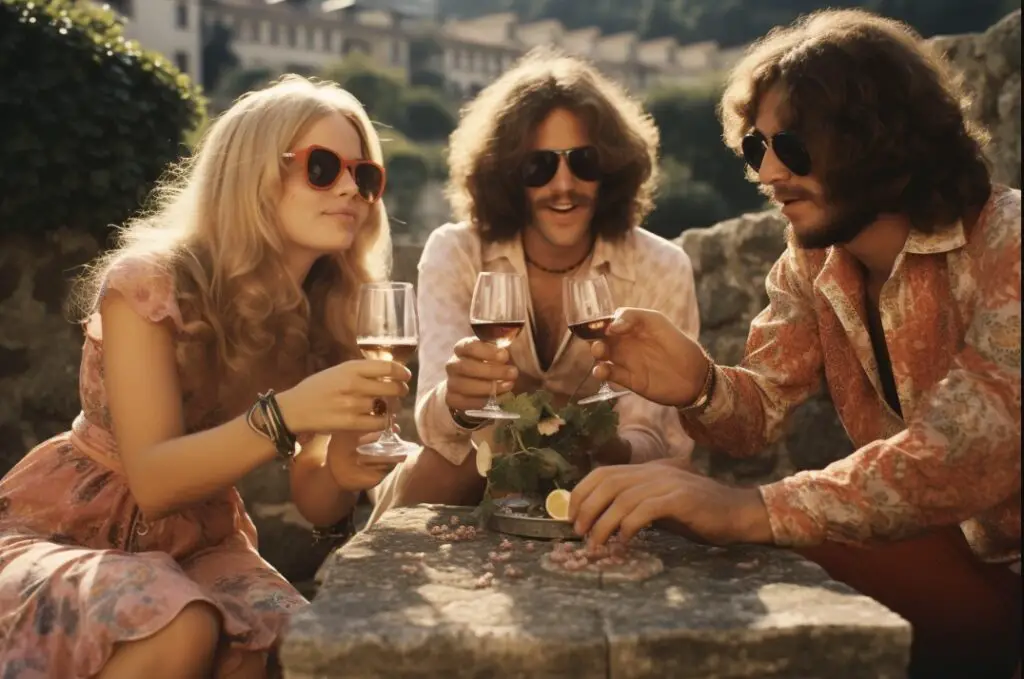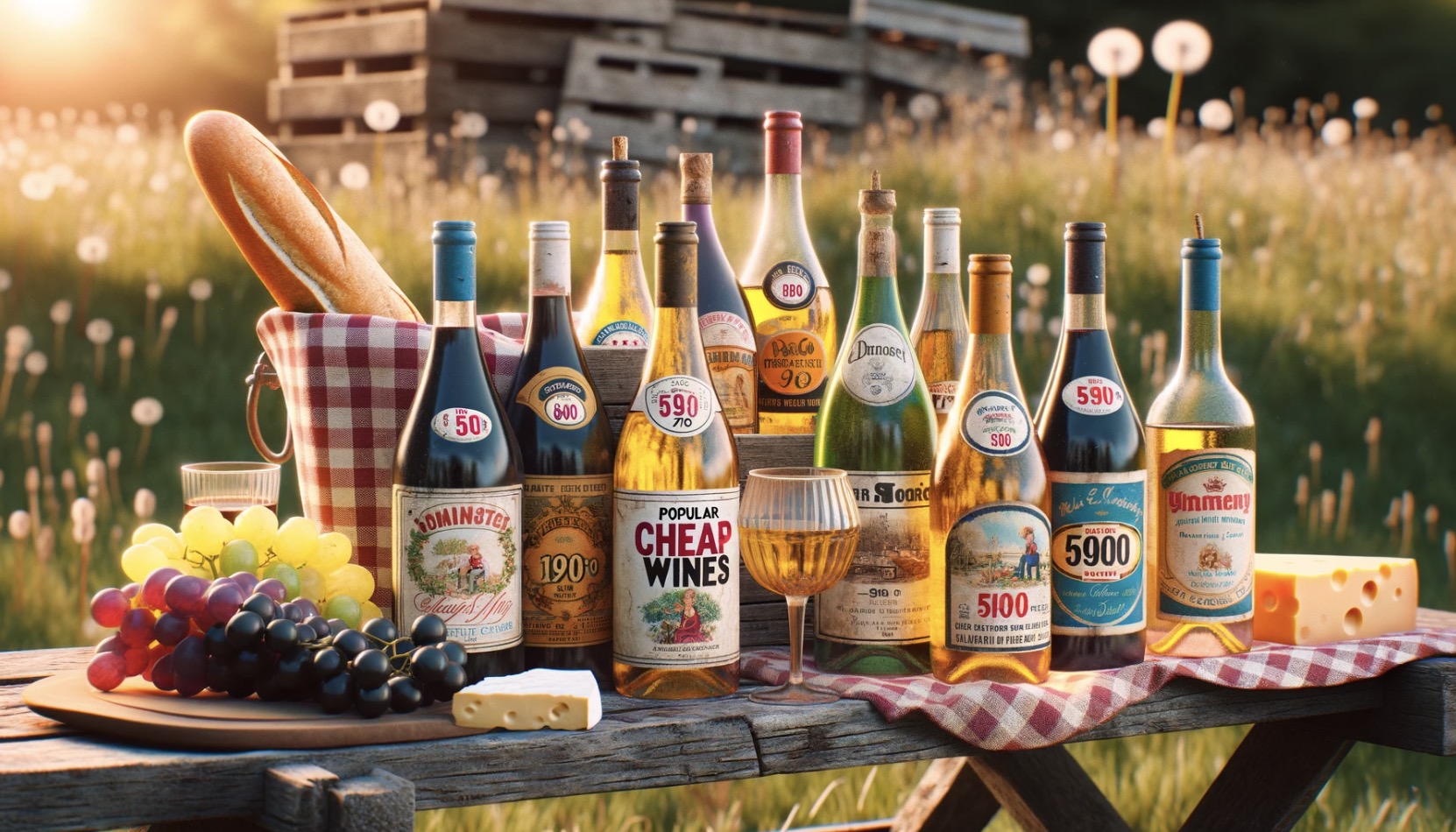The 1960s was an era of great change and innovation, and the wine industry was no exception. During this time, the perception and popularity of wine started to shift, with a particular focus on affordability and accessibility.
Cheap wines became increasingly prevalent, catering to a growing demand for affordable options that didn’t compromise on taste or quality. Let’s take a quick recap of some cheap wines that gained popularity in the 1960s.
Quick recap: Top Cheap wines in the 1960s
- Mateus Rosé: This Portuguese sparkling wine became a sensation in the 1960s with its unique bottle shape and sweet, refreshing taste. Mateus Rosé was affordable and an instant hit among wine enthusiasts.
- Liebfraumilch: Hailing from Germany, Liebfraumilch gained popularity due to its light, fruity flavor and reasonable price. It quickly became the go-to choice for those seeking a budget-friendly wine that was easy to drink.
- Riunite Lambrusco: This Italian red wine, known for its slightly sweet and fizzy characteristics, captured the attention of consumers in the 1960s. Riunite Lambrusco offered an affordable and enjoyable alternative to traditional red wines.
- Gallo Thunderbird: Although not known for its quality, Gallo Thunderbird was a popular choice for those on a tight budget. Despite its low price point, it gained a reputation for its high alcohol content, attracting a loyal following.
These cheap wines of the 1960s allowed wine to become more accessible to a wider audience, solidifying its place in popular culture and paving the way for the diverse wine options we enjoy today. [1][2]
Popular Cheap Wines in the 1960s
During the 1960s, the wine industry saw a surge in popularity, with an increasing demand for affordable options that didn’t compromise on taste or quality.
Several cheap wines gained recognition and became favorites among budget-conscious wine drinkers. Let’s take a look at some of the popular cheap wines of the 1960s.

1. Thunderbird: A favorite among budget-conscious wine drinkers
Thunderbird was a popular choice for those seeking an inexpensive wine option during the 1960s. Despite its relatively low price point, it quickly gained a following due to its high alcohol content. While Thunderbird may not have been known for its quality, it provided an affordable option for those on a tight budget.
2. Mateus Rosé
Mateus Rosé, a Portuguese sparkling wine, gained immense popularity in the 1960s. Its unique bottle shape and sweet, refreshing taste made it an instant hit among wine enthusiasts. Mateus Rosé was not only affordable but also provided a delightful drinking experience.

3. Blue Nun
Blue Nun, a German wine, also gained recognition during this time. Known for its light, fruity flavor and reasonable price, Blue Nun became a popular choice for those seeking a budget-friendly wine that was easy to drink.

4. Lambrusco
Lambrusco, an Italian red wine, captured the attention of consumers in the 1960s with its slightly sweet and fizzy characteristics. It offered an affordable and enjoyable alternative to traditional red wines and became a favorite among wine drinkers looking for something different.

5. Lancers Rosé
Lancers Rosé, a Portuguese wine, gained popularity for its affordable price and pleasant taste. Its light and fruity flavor profile made it a go-to choice for wine drinkers in the 1960s.
6. Ripple
Ripple, a sweet, low-alcohol wine, became popular in the 1960s as a budget-friendly option. Despite its simple and straightforward taste, Ripple attracted a loyal following due to its affordability and accessibility.
7. Boone’s Farm Apple Wine
Boone’s Farm Apple Wine became a hit during the 1960s, known for its sweet and fruity taste. Offering a variety of flavors at an affordable price, Boone’s Farm appealed to a wide range of consumers looking for an easy-drinking wine.
8. Chianti in Fiasco
Chianti in Fiasco, an Italian wine often presented in a straw-covered flask, gained popularity as an inexpensive and approachable option. It offered a taste of Italy at an affordable price point, appealing to those looking for an affordable yet flavorful wine.
These cheap wines of the 1960s provided accessible options for wine drinkers, establishing wine’s place in popular culture and paving the way for the diverse range of wines available today.
Other Notable Cheap Wines
1. Night Train: Known for its high alcohol content
Night Train was another popular cheap wine that gained recognition during the 1960s. Similar to Thunderbird, Night Train was known for its high alcohol content. Although it may not have been renowned for its quality, it appealed to budget-conscious wine drinkers seeking a potent and affordable option.
2. Rossi: A popular choice for its affordability and taste
Rossi was a notable cheap wine that became a favorite among wine enthusiasts in the 1960s. It offered a balance between affordability and taste, making it a popular choice for those on a tight budget.
Despite its lower price point, Rossi managed to deliver a pleasant drinking experience, solidifying its place among the top cheap wines of the era.
These additional cheap wines of the 1960s provided consumers with accessible options that didn’t compromise on taste or quality. They played a significant role in establishing wine’s popularity in popular culture and paved the way for the diverse range of wines available today.
Cultural Significance of Cheap Wines in the 1960s
During the 1960s, cheap wines played a significant role in popular culture, influencing social gatherings, music, and movies. These affordable and accessible options became synonymous with the era’s countercultural movements and youth rebellion. Some of the notable cheap wines of the time included Boones Farm Strawberry Hill, Thunderbird, and Ripple.
The influence of cheap wines on popular culture
One of the most iconic cheap wines of the 1960s was Boones Farm Strawberry Hill. It quickly gained popularity due to its sweet taste and low price, making it a favorite among young people. Boones Farm was known for its fruity flavors and vibrant label designs, which added to its appeal.

Another notorious cheap wine of the era was Thunderbird. It garnered a reputation for its high alcohol content, often being associated with a cheap and potent alcoholic beverage. Despite its questionable quality, Thunderbird found its way into the hands of budget-conscious wine drinkers looking for a strong and affordable option.
Ripple was another popular choice among those seeking a budget-friendly wine. It offered a balance between affordability and taste, making it an attractive option for the working class. Ripple’s affordability and accessibility made it a household name among wine enthusiasts during the 1960s.
These cheap wines not only provided an affordable alternative for wine lovers but also became cultural symbols. They were frequently referenced in popular music and movies of the time, further solidifying their place in the era’s cultural zeitgeist.
The perception and consumption of cheap wines during the era
Cheap wines in the 1960s were often associated with the countercultural movements of the time. They represented a rejection of traditional norms and a celebration of individuality and rebellion. These wines were seen as accessible and non-elitist, appealing to a wider audience.
Their affordability and accessibility made cheap wines a common choice for social gatherings, parties, and music festivals. They were often shared among friends, forming a sense of community and camaraderie. Cheap wines became a symbol of youthful freedom and the desire to break away from established norms.
In conclusion, cheap wines of the 1960s not only provided an affordable and accessible option for wine enthusiasts but also became cultural icons. They influenced popular culture, music, and movies, capturing the spirit of the era’s countercultural movements. These wines represented rebellion, individuality, and a rejection of traditional norms, making them an essential part of the cultural fabric of the time. [3][4][5]
The enduring legacy of cheap wines in the 1960s
During the 1960s, cheap wines left an indelible mark on popular culture and continue to hold a significant place in both nostalgia and wine history. These affordable options, often associated with countercultural movements and rebellion, became cultural icons of the era. Boones Farm Strawberry Hill, Thunderbird, and Ripple were among the most notable cheap wines of the time.
Boones Farm Strawberry Hill gained fame for its sweet taste and low price, making it immensely popular among young people. Its fruity flavors and eye-catching label designs added to its allure.
Thunderbird, on the other hand, became known for its high alcohol content and affordability, making it a popular choice for those seeking potency on a budget. Ripple, balancing affordability with taste, appealed to the working class and solidified its position in many households.
These cheap wines not only offered an accessible alternative for wine lovers but also became cultural symbols referenced in popular music and movies. They represented rebellion against traditional norms, embraced individuality, and celebrated youthful freedom. Cheap wines were a common choice for social gatherings, parties, and music festivals, creating a sense of community and camaraderie.
In conclusion, the cheap wines of the 1960s continue to hold a lasting legacy. They influenced popular culture, music, and movies, capturing the spirit of the countercultural movements of the era. These wines represented more than just affordability; they embodied a rebellious spirit and a desire for individuality, making them an essential part of the cultural fabric of the time. [7][8]





Leave a Reply
You must be logged in to post a comment.